4654Views 42Comments
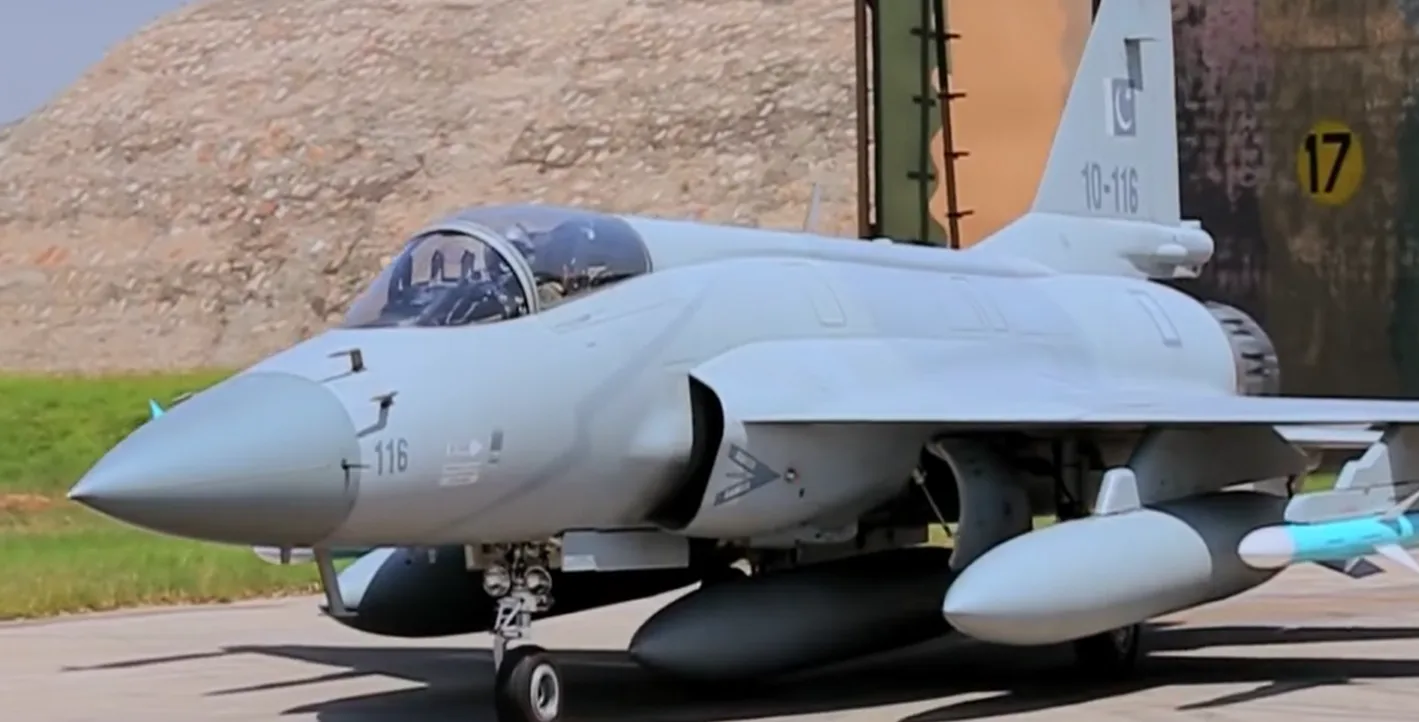
The JF-17 III: Major Changes Ahead on JF-17 Block-3
By Bilal Khan
Previous articles on Quwa discussed why the JF-17 is a significant advancement for the Pakistan Air Force (PAF). Not only is the JF-17 an effective multi-role platform that is poised to form the backbone of the PAF fighter fleet, but it is immune to sanctions, and it is a program that Pakistan ‘owns’ in terms of being able to freely decide on how to equip and develop it. With this article, it would be a good idea to have a clearer understanding of exactly what the PAF has in store for the JF-17 in the coming years in terms of its upgrade and development path. By the end of this piece, there should be little doubt in the seriousness of the PAF in as far as its commitment to the JF-17 is concerned.
The first upgrade to the JF-17 is at this time coming through the Block-2. The first JF-17 Block-2 made its maiden flight in February 2015, and it is the current production type rolling out of Pakistan Aeronautical Complex (PAC) Kamra. The Block-2 is at heart an iterative update, so it would not be right to assume that it includes significant improvements or changes over the Block-1 currently in service.
Arguably, the most significant change in the Block-2 is the incorporation of an air-to-air refuelling (AAR) probe, and this will enable the JF-17 to refuel in-flight with the support of the PAF’s IL-78 tankers. The Block-2 also incorporates improvements in the JF-17’s avionics and electronic suites, but there are no specific details. There are rumours about a KLJ-7V2 pulse-Doppler radar with increased range, but this has not been confirmed by the PAF or PAC. If one were to simply refer to this piece by Jane’s, it would seem that the Block-2’s goal is to increase the JF-17’s flight-time (via in-flight refuelling and improved oxygen systems) and mission usefulness (in-flight refuelling can free up hard-points that would otherwise be used for external fuel-tanks). The 51st to 100th JF-17s will be Block-2.
The first major jump is in reality the JF-17 Block-3, which is currently in development. There are no known airframe updates or changes in the Block-3, but in terms of electronics, it is essentially confirmed that the JF-17 Block-3 will house an Active Electronically Scanned Array (AESA) radar, Helmet Mounted Display and Sight (HMD/S) system, and possibly an additional hard-point suitable for specialized targeting and tracking pods. This article will breakdown each of these aspects, but if taken together (alongside a suitably upgraded avionics and ECM/EW suite), the Block-3 is positioned to be a significant upgrade.
Active Electronically Scanned Array (AESA) Radar
The integration of an AESA radar is perhaps the most important development in the JF-17’s upgrade path. AESA radars are complex and expensive systems, but they are a standard feature of 4.5 generation fighters such as the Dassault Rafale and Eurofighter Typhoon. In a battlefield environment that is increasingly ridden with electronic warfare, AESA radars can help fighter aircraft resist enemy jamming, thus helping said fighters successfully engage their targets.
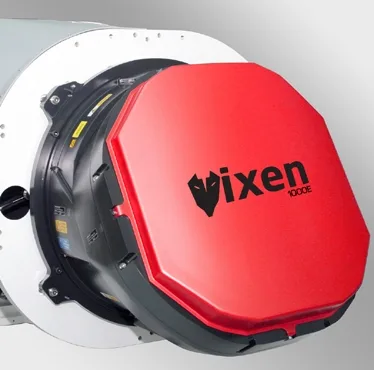
An AESA radar is equipped with many small solid-state transmit/receive modules (TRM), and each TRM is capable of emitting its own radio wave. There are many advantages borne out of this arrangement.
The first is “low probability of intercept.” For example, an older radar would typically send out a single signal per pulse, and that signal will be received by the target’s receiver. Over time, that receiver will recognize that the specific signal that “stands out” of the environment (or background noise) is an enemy’s radar, and thus, the aircraft using its radar will have its presence exposed. An AESA radar on the other hand is much more difficult for radar warning receivers (RWR) to interpret as that radar is not just one unit sending one signal, but many small TRMs sending different signals. In general, RWRs would have difficulty pinpointing a peculiar signal (or limited set of signals) from the background noise, thus giving the AESA-equipped aircraft a “low probability of intercept.” In general terms, the AESA- equipped fighter is more difficult to detect.
The second advantage is higher resistance to jamming (from an adversary’s electronic warfare suites). Older radars cannot as easily change their frequencies, and as a result, a jamming system would have a higher chance of registering that specific frequency and sending out that very same one to confuse the pulsing aircraft. Modern radars could change their frequencies with every successive pulse, but an AESA radar could go a step further by emitting different frequencies within a single pulse. Here, jamming would become much more difficult as there is no single frequency to expose from the background noise. Given that an AESA radar is composed of different TRMs transmitting discrete signals, groups of TRM can be allocated to take on specific tasks, e.g. one can engage in targeting, the other in counter-jamming.
If the JF-17 were equipped an AESA radar, its ability to withstand enemy jamming as well as close in on enemy targets with a low probability of intercept would make it a much more effective system. That said, it is important to note that while an AESA radar can offer these advantages, it is imperative that one not sacrifice tracking range and engagement capabilities. If the PAF wishes to see the JF-17 Block-3 substantially improve upon the Block-1 and Block-2, then it should ensure that its AESA radar substantially improves upon the KLJ-7’s range and ability to engage targets. In other words, the JF-17 Block-3’s AESA radar could very well be an expensive system, and that will likely serve as an impediment.
Speaking of impediments, there is also the question of sourcing. In an article meant for the 2015 Paris Air Show, Alan Warnes (a very credible PAF watcher) noted that a radar from the British-Italian firm Selex ES was in the running. On a DefenseNews piece, retired PAF Air Commodore Kaiser Tufail was quoted saying, “Given the Western concerns about transfer of sensitive technology, which could find its way further east, I think we may have had no other option but to buy Chinese.” This is an extremely important point. AESA technology is new and it is very sensitive, so the PAF can (and likely will) run into serious issues when it comes to Western suppliers (e.g. the latter might demand overbearing checks and guarantees, and possibly refuse to let Pakistan produce the radars locally). It is very likely that the PAF will ultimately eschew its Western options and go Chinese, especially if the latter enables the PAF to learn and understand AESA technology more deeply and bring this prized technology to local production.
Helmet Mounted Display & Sight (HMD/S)
The incorporation of HMD/S is also a very important step for the JF-17. An HMD/S is basically a visor equipped with optical and processing systems (in other words, a ‘smart display’). Current day HMD/S systems like the Joint Helmet Mounted Cueing and Sight (JHMCS) system enable a fighter pilot to cue their air-to-air and air-to-surface weapon systems to the direction of where his or her head is pointing. Targets can be designated and engaged with minimal aircraft maneuvering, thereby increasing the efficiency (and thus lethality) of the fighter in combat.
Although slotted for the Block-3, it seems the PAF was at least toying with the idea of some kind of HMD on JF-17 for a few years. The proof for that is this screen-capture (below) taken from a PAF documentary from 2008 called “In Pursuit of Self Reliance.” Although the PAF could have tacked on a random image, there is a clear hint that this particular system (which has a startling resemblance to the Denel Archer from South Africa) may have been at least tested by the PAF. For one thing, the Gentex MBU-5/P oxygen mask that was – at least in 2008 – the standard issue mask for PAF fighter pilots (though that is gradually being supplanted with current MBU-20/23 masks). Moreover, this specific photo was only ever shown on the PAF documentary and nowhere else prior.
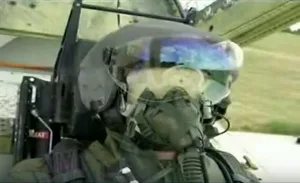
This image would suggest that the PAF was (and possibly still is) cooperating with numerous foreign vendors on the JF-17’s HMD/S system, especially if the Brazilian-South African A-Darter high-off-bore-sight (HOBS) within visual range air-to-air missile (WVRAAM) is in the running for use on JF-17. A HOBS WVRAAM can be paired with an HMD/S system to allow the pilot to utilize the system’s cueing advantages in dogfights with enemy fighter aircraft.
At this stage it is difficult to see exactly where the HMD/S system will come from, but there is a chance that this might be a solution that is heavily centric to the PAF’s specific needs. In other words, the HMD/S might in fact end up being an indigenously-sourced solution developed with external assistance, primarily Chinese with peripheral South African, European and possibly even Turkish support. The rationale for this argument is the reality that the JF-17’s HMD/S will need to be accessible to the full range of potentially compatible air-to-air and air-to-surface munitions in use by the PAF. An imported solution with limited access to the technology will limit the PAF from freely using the system, thus mitigating the actual need and advantage of the JF-17.
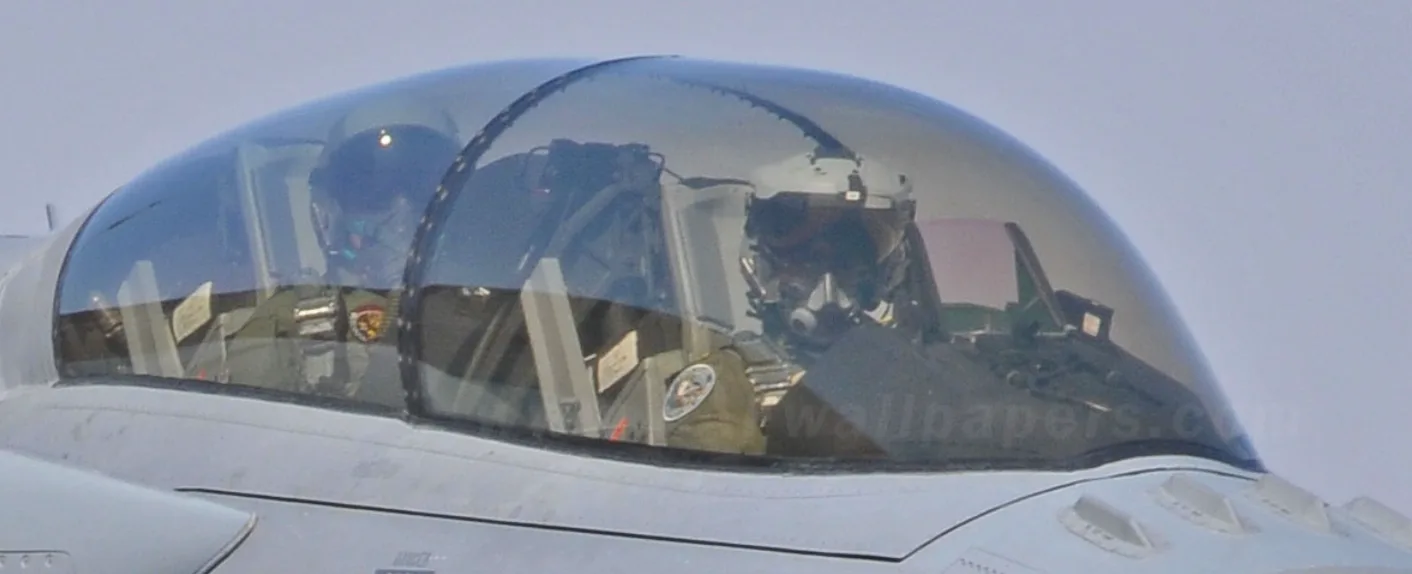
It is important to note that the PAF already uses an HMD/S system with its F-16s, the Boeing JHMCS. There is a good chance that the JHMCS is in fact influencing the PAF’s idea of a suitable HMD/S, and as a result, one might see the PAF’s solution adopt a few similar characteristics. For example, the JHMCS was designed to be adapted to a modified HGU-55/P helmet, the standard issue helmet in use by the U.S Air Force and many other air forces, including that of Pakistan’s. Modularity and flexibility are key advantages to have, and a possible solution might even mirror the Thales Visionix “Scorpion” Helmet Mounted Cueing System (HMCS). The Scorpion was developed to essentially fit onto the HGU-55/P helmet with an add-on mount, the mount could also be used to fit night-vision-goggles (NVG) in lieu of the HMD/S visor.
Additional Station for Specialized Targeting Pods
It is possible, though not clearly verified, that the JF-17 Block-3 would have an additional station or hard-point (likely under the fuselage, by the ‘chin’) to house special-purpose targeting pods.

One incredibly useful-kind of pod would be a system similar in form and function to the Lockheed Martin Sniper Advanced Targeting Pod. The Sniper (which is also used on the PAF’s F-16s) is a multi-purpose pod that allows for tracking, targeting and engagement irrespective of the time of day or the weather. The Sniper can be paired with a wide range of air-to-surface weapon systems, including laser-guided bombs (LGB) and TV-guided stand-off missiles such as the AGM-65 Maverick.
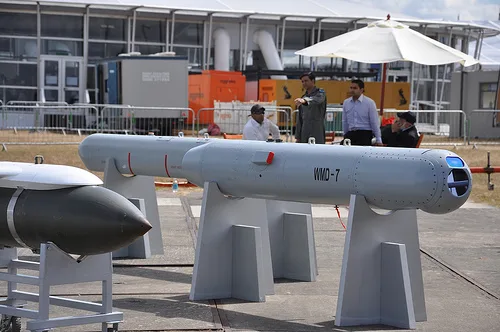
Although the JF-17 could house such a pod in one of its existing hard-points, if the pod were in fact light and deployable in a separate area, the JF-17 would be able to utilize all of its existing stations for actual munitions (and fuel-tanks, if aerial refuelling were not available or sufficient). An advanced targeting pod could greatly improve the JF-17’s capacity to undertake stand-alone (i.e. without satellite-aided guidance) precision-strikes using LGBs such as the LT-2 as well as TV-based stand-off glide-bombs such as the locally produced H2 and H4.
Possible Additions and Upgrades
One system that would be of use to the JF-17 is Infrared Search and Track (IRST). Ideally, the IRST system ought to be integrated into the nosecone of the fighter, but it is unclear if the PAF is actually going to take this route. IRST can be used to track enemy aircraft based on thermal signature using infrared, which allows for passive tracking (as opposed to the active tracking of a radar, which sends out pulses). In a scenario where enemy electronic warfare capabilities are of exceptional depth or where there is need to reduce the probability of intercept to the absolute minimum (below that of an even an AESA radar), an IRST-system can be used instead of radar. An IRST system can be paired with a 5th-generation HOBS WVRAAM, enabling the JF-17 to dogfight with minimal effects from enemy EW jamming.
Another area of discussion is the JF-17’s turbofan engine, the Russian RD-93 (a variant of the RD-33 used on the MiG-29). A higher thrust engine such as the in-development RD-93MA can help the JF-17 in achieving a better thrust-to-weight-ratio (TWR), enabling improved maneuverability, speed and payload. Again, it is unclear if an engine change is on the horizon for the JF-17 program, and if so, whether it would be incorporated as early as the Block-3. A new engine may be more likely on a later variant, especially if said variant exhibits a lighter airframe (as a result of a higher proportion of composite use).
Concluding Remarks
When taken collectively, the major changes coming with the JF-17 Block-3 will offer a significant leap for the PAF. It is important to remember that this upgrade will not be confined to a few planes, but in time it will be diffused across the rest of the PAF’s JF-17 fleet. The Block-3 will probably be the upgrade that defines the JF-17 more as a high-tech asset and a potent force-multiplier.

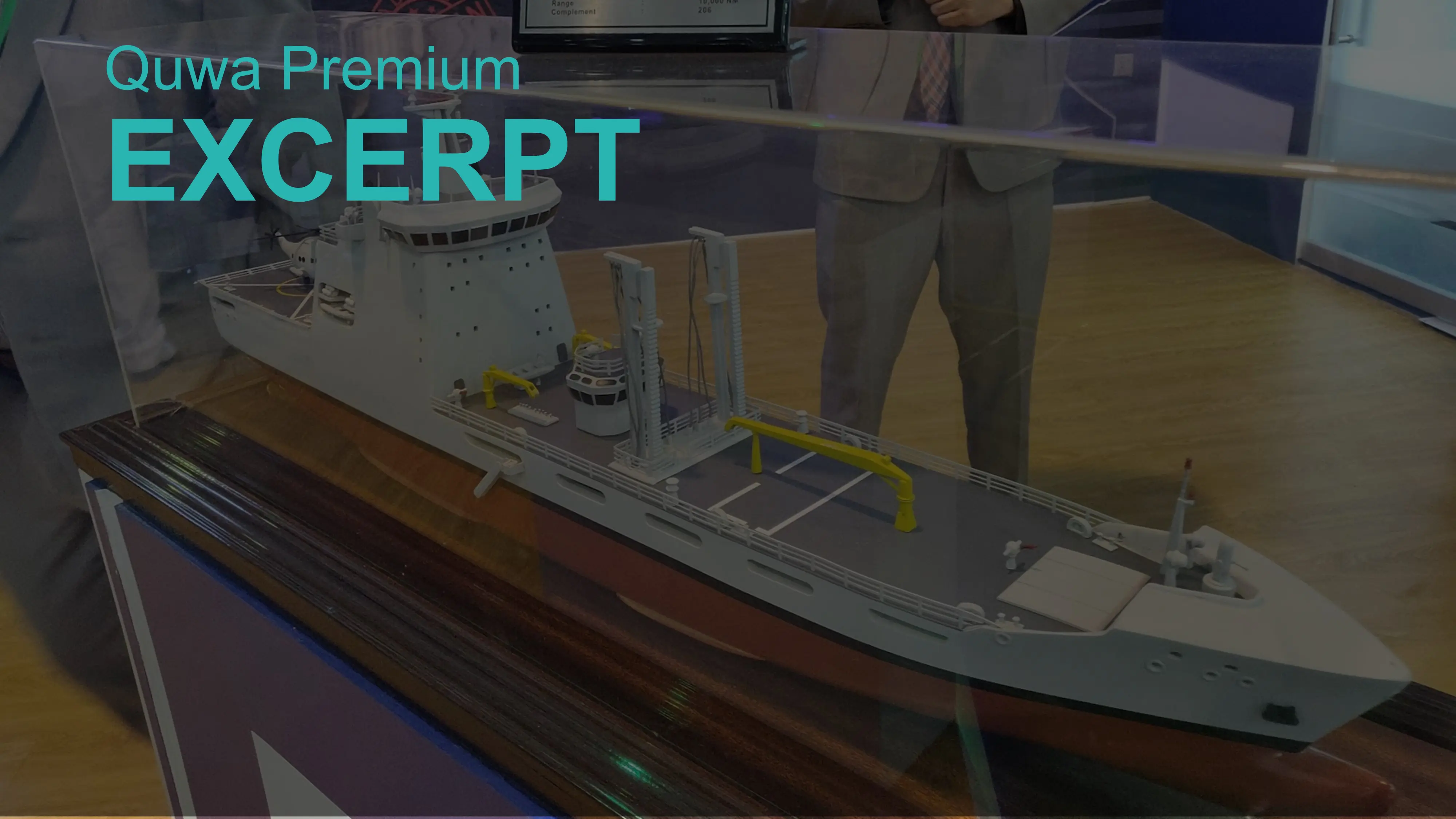
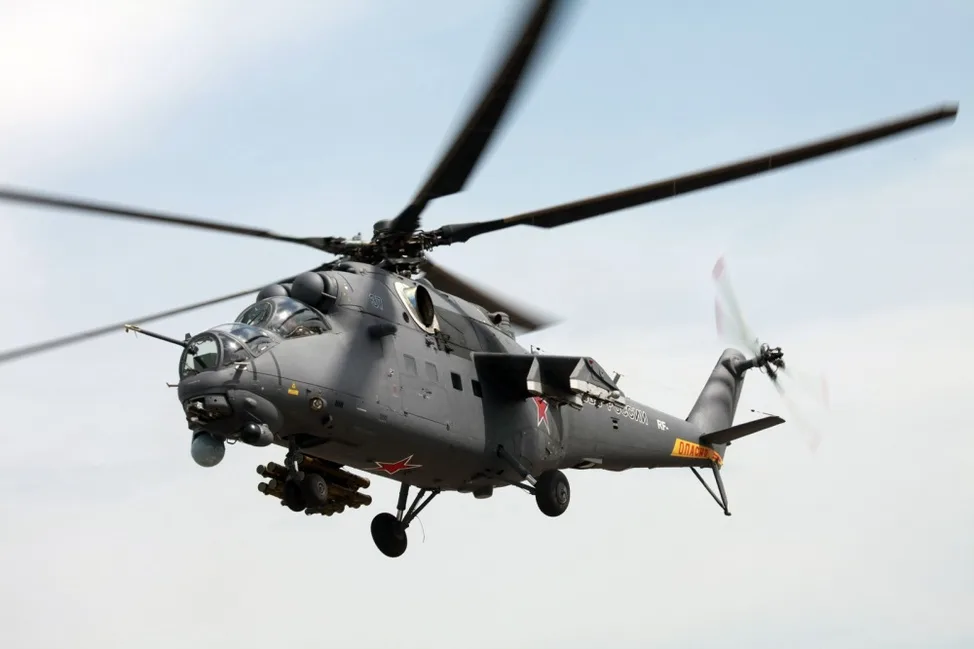
42 Comments
by jigsaww
What about additional weapon load, more hardpoints, composities, and integration of more weapon systems?
by saqrkh
I will discuss future weapon systems in a later article, but I’d say 4th and 5th gen HOBS WVRAAM would be the most obvious additions. The most likely candidates, A-Darter and MAA-1B, are still in development though.
Besides that, I expect we’ll regularly see JF-17 incorporate more air-to-surface systems, especially stand-off munitions and the Ra’ad ALCM. But I don’t think these additions are tied to Block-3 specifically, we might see them in Block-2.
I don’t think there will be any significant airframe changes on Block-3.
Block-4 and later though might be a different story. I think the PAF should consider making the JF-17 airframe lighter (via a higher proportion of composites) and giving it a more powerful turbofan. Combined, these two elements can enable the JF-17 to have a greater payload, additional hardpoints for weapons, etc. It will also broaden the JF-17 up for more specialist roles, e.g. ECM/EW (akin to EA-18 Growler).
-Bilal Khan
by jigsaww
thanks, very informative. will wait for more
by Biased
Extremely informative article. Nevertheless, a discussion about Pakistan’s choice of ultra long-range BVRAAM in the class of Meteor, AIM-120D to fully exploit an AESA sensor would have been germane with other useful aspects dealt with in this article.
by saqrkh
It was tough to go there since there’s practically nothing to go by in terms of PAF selecting a LRAAM. But I am going to do a piece exploring PAF’s ties with South Africa since that (after China) would be a leading route for PAF (see new T-Darter). In fact, given the feedback, it’d be a good idea to discuss future munitions for JF-17 in detail.
-Bilal Khan
by jigsaww
please post new articles. waiting eagerly 🙂
by Soldier
what about JF-17 AFT visibility? is there any consideration of improving cockpit design to high seat configuration for all around vision ???
by Soldier
What is the status of A-Darter incorporation? Long ago it was stated by PAF officials that they are anxiously waiting for this missile
by saqrkh
I honesty hope for this as well, but it’ll depend on whether PAF wants to do significant work on the airframe. If there is no other fighter on the horizon (e.g. F-16, J-10), then I think we will see PAF work on improving JF-17 in its TWR, cockpit visibility, range and payload. But then again, someone might just raise the point “why not develop or buy a new fighter?”..
by saqrkh
Soon 🙂
by saqrkh
The A-Darter is still in development, so it’s not going to figure into the PAF’s equation for at least a few years, perhaps as late as the 2nd or 3rd Block-3 squadron. That said, it was mentioned by Alan Warnes as an option as recently as the Paris Air Show (via his brochure), so it is still on the cards as far as PAF is concerned.
Furthermore, there was a news report a few years ago claiming that the PAF was interested in the MAA-1B, a 4th gen WVRAAM. If it enters service before the A-Darter, then the PAF might be interested in picking that up instead.
by Soldier
I agree they have to design JF-19 for this , I don’t know why designers didn’t take it seriously at first place the fat spine gives a look of obsolete design ….
by saqrkh
The PAF agreed to the design in 1995, I imagine the pressure from sanctions was being felt and there was an urgent need for a newer and more capable fighter. In the early 2000s they went back to the drawing board, and we got the JF-17 we see today.
At that time cost and mitigating risk were the main considerations, and so, they got a fighter that wasn’t the best in terms of performance.
What they can do now is inquire if the Chinese are sitting on a next gen design that could serve the role of light/medium-weight fighter of the future. Or the PAF can just double down on J-31 and buy a sizable enough number to justify local manufacturing.
by Soldier
Exactly … as far as I remember back in the years around 2004 I can recall the Air cheif’s interview at PTV that “JF-17 is not meant to replace F-16 neither it is as good in performance as top of the line fighters, it is just to replace our lower end fleet like mirage and F-7PG’s which is a huge step forward” …
But later when Air force modernization program sent to hellllll then JF-17 got the spot light and now being presented as backbone of PAF……
by saqrkh
Whether it is great or not great, it was always meant to the backbone, but I agree, it isn’t something the PAF can comfortably operate for more than 20 years given the advancements seen in the aerospace industry.
That said, I am not entirely sure what the PAF would do post-JF-17. Would it simply pick up an existing 4+ generation design and have it manufactured in Pakistan under license? Or perhaps would it take the daring step of trying to figure out what a post-5th gen design ought to be?
by Rehan
How chinese AESA radars are compared with SELEX AESA radars and please throw some light on that Chinese AESA radars are copied from Israelies one.
by saqrkh
To be honest, I don’t know, sorry 🙂
That said, it is quite the accomplishment for the Chinese electronics industry to come up with AESA solutions so soon. But the experience of other Western vendors should always be factored in.
by navid lahori
A few years back,a Chinese engine website mentioned WS-13 as a joint venture of China and Pakistan.Later on this mention of joint venture disappeared .Do you have any info regarding this aspect of engine development.
by saqrkh
Unfortunately I don’t. Sorry.
by amer amin
Instead of Thinking about F 22 or anything else I think it is very good that Pakistan is learning to build fighter jets
by zach amin
No Iran is not the enemy of Pakistan. It is an Indian hoax story to give false impression. In fact, Iranis developing railway tracks to connect IRAN with Baluchistan to become a vital part of CPEC. Pakistan.
by Sami Shahid
Russia has agreed that it will provide RD-93 engines directly to Pakistan….BTW block 3 will also have a dual seat version and the block 3 will have new engine possibly mach 1.8
by Majid naqvi
You are most welcome brother
by Sami Shahid
JF-17 project going well…
by Abdul Basit
well this whole discussion is very informative to me and according to my point of view that
Block III should be equipped with new engine there are many engines like of Sukhoi
( As Pakistan is interested in Su-35 jets then why not purchase their engine and incorporate in JF-17 and make them much better in performance, maneuverability and other aspects),
Mikoyan, Chinese & European engine manufacturing companies and literally i would say just start a JV for engine manufacturing in Pakistan.
i don’t know about the composite of Jf-17 Block I & II but if there is better engine added in Block III then the composite should be changed and cockpit modifications as below mentioned by a friend below.
I heard about the sniper pod acquiring from Turkey! (if from Chinese then manufacture in PAC)
PA should move to the next step of EW in every field and try to start some projects of EW.(if Pakistan have started then its okae because i don’t know much)
by Abdul Basit
i heard that rd-93 deal is been cancelled :/
yup going well but changing engines will make a big change
by Tar TwoGo
Iran a muslim country enemy of hindu india.
by Sj Sharjeel
block III must be in service till 2018, & RD-93 engine is suitable for JF-17 which produce high thrust, according to me PAC should get inspiration to develop these engines locally, we need to learn from these components like WMD-7 targeting pod, AESA Radar & develop them locally..
by kashif
bilal pakistan air chief said if we will r not get success in making jf17 then we start working on chinise fifth generation fighter it is possible that we r not successful in making jf17
by Bilal Khan - Quwa
ACM said no such thing.
by Ozair Akhtar (Oxair Online)
I Don’t Know – I am Pretty sure that PAC-NESCOM is working on something really great! Pakistan Zindabad!
by Noman Abid
we know that now brother thanx
by Omer Shah
Iran is being said an enemy of Pakistan becoz of it’s relationship with Russia but I don’t care I want Muslims unite no sunni,shia etc.And I now Iran will not go against Pakistan and nor the Saudis.????????
by Zeeshan Khan
Actually not enemy but favours india
by Zeeshan Khan
Bilal bro i want some of the latest information about the little bird.
Will we upgrade the former series of block 1 and 2 with block 3 upgrades?
Which BVR is used currently in JF 17 active service?
by Bilal Khan
1. No firm info yet on if, when and how the Block-I and Block-II will be upgraded.
2. SD-10
by Octavio Araujo
Is there any news on the design of the JF-17 Block 3? Will it have a different look or will it looks the same with minor alterations?
by Bilal Khan
http://quwa.org/2017/04/30/jf-17b-foundation-jf-17-block-iii/
by sami shahid
We should definitely make JF-17 a competitor of F-16 block 60 for ourselves & for export purpose. HMD, AESA & Sniper are really very important for JF-17 as India has bought Rafale and Rafale has all these qualities.
by sami shahid
China has installed an improved version of WS-13 on FC-31 stealth.
by sami shahid
New improved version of WS-13
by sami shahid
WS-13